Square Foot Gardening Building Raised Beds
Do you want to grow a vegetable garden, but don't have a lot of room? Square foot gardening is a great way to grow vegetables. You don't have to worry about digging a garden because the raised beds are placed on top of the ground.

Mel Bartholomew developed the square foot garden concept in 1976. He published his Square Foot Gardening book in 1981, and it has been revised several times through the years. We built our first square foot gardens after reading All New Square Foot Gardening in 2009.
The theory of square foot gardening is to use a bottomless raised bed filled with a soil blend of equal amounts of peat moss, vermiculite, and finished compost from many different sources to add a diverse amount of nutrients.
Instead of planting in rows, the bed is divided into one-foot sections, and each square is planted in grids according to the spacing recommended on the seed packet and described in the book.
Building a square foot garden is a quick and easy way to begin or expand your garden. The method is also simple to understand, organized, and makes it easy to plan your growing beds. You can learn more about the benefits of square foot gardening in this article:
- 10 Benefits of Square Foot Gardening
Steps to Building a Square Foot Garden
We started out building three 4×4 square foot garden beds the first year and placed them to the south end of our garden area. We found the 4×4 size simple to build with standard lumber, and the beds lined up well with our existing garden space.
One of the benefits of raised bed gardening is you will never compact the soil by walking on it. So you want to build the beds so you can reach into the garden on all sides from the outside the garden. We left about 3 feet in between the beds, which is plenty of space to walk and maneuver a wheelbarrow and manual lawn mower to keep the grass paths trimmed.

We added three more 4×4 square foot beds the following year. Each year we built, filled, and planted three beds in just one weekend. Here is how we did it:
Step 1: Source the material
You will need the following for each 4×4 square foot garden:
- Two 8-foot long 2×6 boards
- A box of 6-inch exterior wood screws
- Power drill
- Recycled cardboard or newspaper
- 3 cubic feet peat moss (or coconut coir or other soil less growing medium of choice)
- 3 cubic feet vermiculite
- 3 cubic feet of blended compost made from at least 5 different sources
- String and small nails to make the grid
- Tarp or garden cart to mix the soil
- Plus basic gardening tools such as a shovel, rake, and garden hose with spray nozzle.
Wood for Raised Bed Gardens: The wood that you use to build your square foot garden is going to be constantly in contact with damp soil, so it will rot over time. Use untreated lumber for building raised beds. Treated lumber may leach chemicals into the soil. Also avoid recycled wood when you don't know the origin because it too may contain unwanted chemicals.
Cedar and redwood are naturally water-resistant, but can be pricey and difficult to find. Fir and pine are the least expensive, but you may need to replace it after several years of use. We started out with pine. Once the pine rotted, we rebuild our gardens using rough hemlock from a local lumberyard. It's been 8 years and the hemlock is just beginning to deteriorate. Ask the lumber company if they can cut the wood into 4-foot pieces for you.
Square Foot Garden Soil Mix: You will need about 8 cubic feet of soil (0.3 cubic yards) to fill one 4×4-foot box at 6-inches high. If your boxes are a different size, you can figure out how much soil will be needed by multiplying the widths of the box, and divide that number by 2. For example, a 4×8 foot box that is 6-inches high would be (4×8)/2 = 16 cubic feet.
The classic soil mix for square foot gardening is equal parts peat moss, vermiculite, and compost.
Peat Moss or Coconut Coir: Peat moss is partially decomposed remains scraped from the surface of peat bogs in the northern US and Canada. Peat is commonly used as a soil amendment to lighten the soil, hold moisture, and improve soil structure. Peat doesn't contain any nutrients. Although peat moss is recommended for garden soil mixes, it isn't a resource that is renewable. Peat bogs can take at least 25 years to renew.
Coconut coir has emerged as a more sustainable replacement for peat moss in potting mixes and garden soil. Coconut coir is a byproduct of the coconut processing industry and is made from the outer husks of coconuts that are grown for food. The husk is ground into a lightweight fiber that provides the same benefits as peat moss, including improving soil structure and moisture retention. Coconut coir is sold in compressed blocks that expand when wet.
Vermiculite: Vermiculite is a natural mineral that is mined out of the ground. Once the rock is collected, it is ground into pieces that are and heated until they explode just like popcorn forming nooks and crannies that hold moisture. Vermiculite is used to improve aeration and texture in the square foot garden mix.
Compost: Finished compost is decomposed organic matter, and it is the best material to grow your plants. Compost will provide nutrients, improve soil structure, and help retain moisture in the soil mix. Compost also feeds earthworms and other microbial life in the soil. The worms will tunnel through the soil to improve aeration and drainage while leaving behind their castings to increase soil fertility.
The best compost is one that you make yourself using organic matter from kitchen scraps, garden debris, grass clippings, and other natural waste. If you need to purchase compost, the book recommends combing organic compost made from at least 5 different sources to provide a wide range of nutrients for your plants. For example, combine decomposed farmyard manure with fish and seafood compost, bat guano, mushroom compost, and mixed compost made from forest products.
Instead of mixing your own square foot garden soil, you can also purchase good-quality pre-mixed raised bed garden soil in bulk from your local garden center.
Step 2: Build the square foot garden boxes
Measure and cut the boards to 4-foot sections. Pre drill 3 holes on one end of each board. Position the boards end to end into a square, and screw them together using 6-inch wood screws.

Step 3: Position the raised beds
Trim the grass low with a lawnmower or weed whacker, and position the boxes in your garden area. Place a layer of newspaper or cardboard beneath the boxes on top of the ground. The cardboard will kill the grass and decompose over time helping to eliminate weeds from growing in the new garden beds.
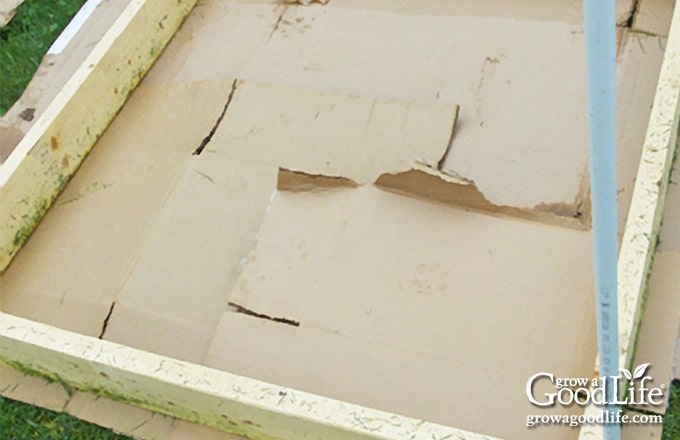
Step 4: Mix a batch of garden soil
The classic square foot garden soil mix is made from 1/3 peat moss, 1/3 vermiculite, and 1/3 finished compost from several different sources. Measure by volume, not weight. We used a 5-gallon bucket to measure out equal amounts of each ingredient.
Combine the three ingredients in a wheelbarrow, garden cart, or on a large tarp. The dry ingredients are very dusty. It is a good idea to wear a mask so you don't breath it in. Mist with a garden hose to keep the dust down, but don't saturate the soil until it is in the boxes.
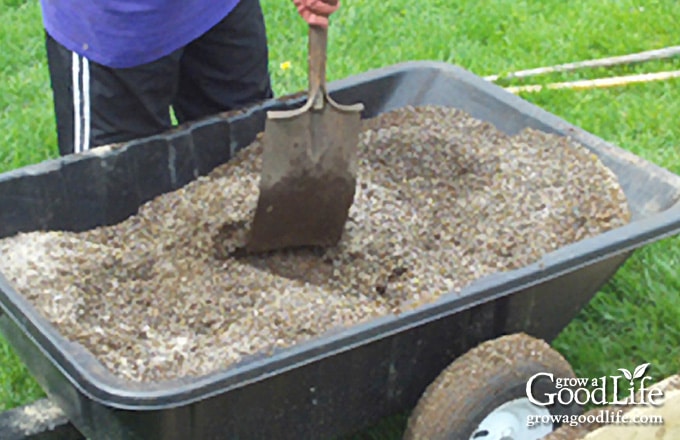
Step 5: Fill the beds with the soil mix
Add the blended soil mix to your raised beds. As you add the soil, hose it down several times so the entire mixture is well saturated. When the boxes are full, give them a final soaking to ensure the mix is hydrated.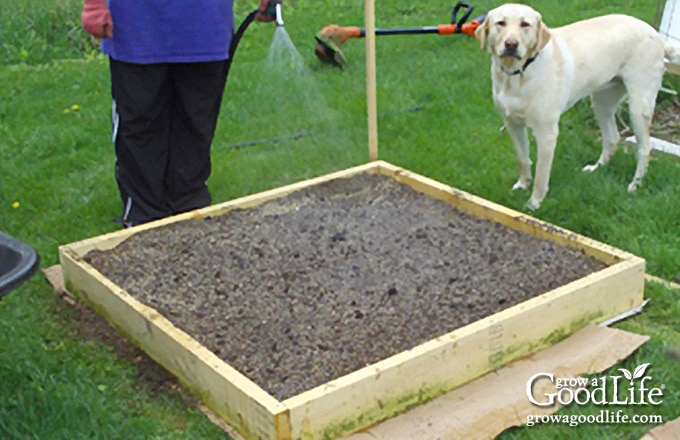
Step 6: Add your grids
Divide the bed into one-foot sections and add a permanent grid. I have used string and small nails to make the grid. You can also use mini blinds, wooden dowels, wood laths, or any thin strips of wood to make your grid.

Step 7: Plant your square foot gardens
Your garden is now ready for planting. If you haven't yet, plan out your garden by drawing a garden map so you know where everything will go.
- How to Make a Garden Map
As you plot out your square foot garden, use the spacing recommended in the book, All New Square Foot Gardening and map out the number of plants in each square. Remember to place tall plants along the north side of your beds, so they don't shade the shorter plants.
If you don't have the book, you can determine the plant spacing using the directions on the back of the seed packet. Refer to the distance required for thinning. This distance then determines whether you are going to plant 1, 4, 9, or 16 plants in a square. For example, "thin to 6 inches apart" is the same as spacing as 4 plants per square.
Instead of scattering seeds and thinning a lot of extra plants, sow only 2 to 3 seeds and space in a grid format, and thin extra plants with scissors to let the strongest seedling mature.
Square foot garden plant spacing:
- Extra Large = 1 plant per square (12 inches apart)
- Large = 4 plants per square (6 inches apart)
- Medium = 9 plants per square (4 inches apart)
- Small = 16 plants per square (3 inches apart)
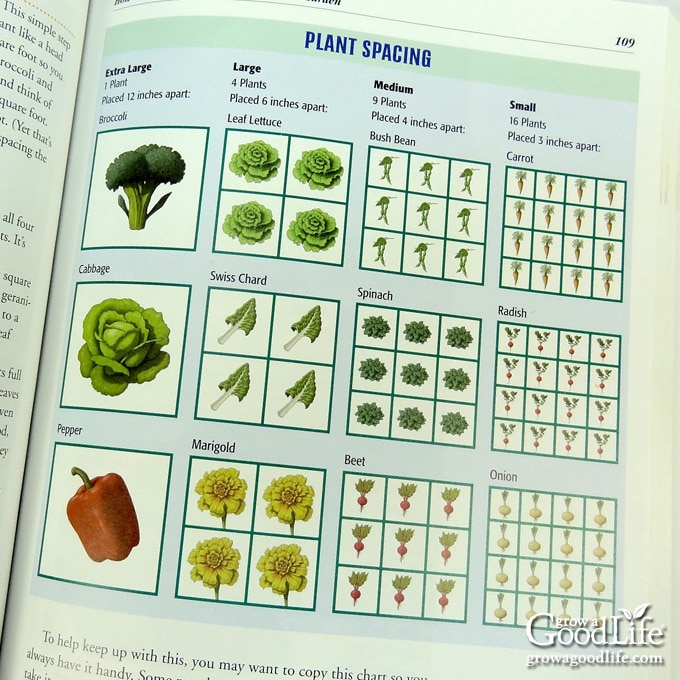
Check out this article for an example of a salsa garden layout out using a 4×4 square foot garden with a trellis: How to Grow a Salsa Garden in a Square Foot Garden.
Additional Square Foot Gardening Tips
It has been over 10 years since we built our first square foot garden beds, and we still continue to use the square foot gardening method today. Here are some things we learned along the way:
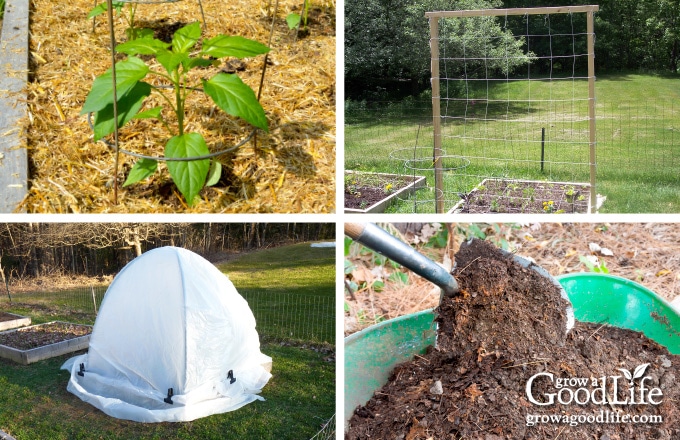
Mulch the Soil Surface: Mulching is the best way to prevent your garden beds from drying out. Once the plants begin to sprout and grow, mulch the soil to conserve moisture and prevent weed seeds from taking hold. Learn more about garden mulch here:
- 5 Ways Organic Mulch Helps Your Garden
Grow Vertical: You can add a trellis to the north side of the bed to grow vining crops such as pole beans, indeterminate tomatoes, or cucumbers. Growing vegetables vertically will help save space in the garden.
Extend the Growing Season: Make a dome to extend your growing season by growing under protection. Crisscross two PVC pipes and drape the beds with garden fabric or even a painting drop cloth. Just remember to vent on warm days. This is also a great way to protect your plants from an unexpected frost.
- 13 Quick Growing Vegetables for Your Fall Garden
- How to Protect Plants from Unexpected Frost
Build Healthy Soil: If you are starting out with a good quality soil with lots of compost from several different sources, you won't have to worry about fertilizing the garden the first time you plant it. However, maintaining healthy soil and fertility is an ongoing process.
When it comes time to plant something new, add some finished compost to the square before planting. Plan on adding compost to the garden every time you plant a new crop. Learn more about healthy soil in this article:
- 7 Ways to Improve Garden Soil
—
The Square Foot Gardening method is worth considering if you are just starting a garden or want to expand quickly with no digging or tilling required. The method is simple to understand and makes it easy to plan your growing beds. Simply build the beds, fill them with soil, and plant according to the charts in the book.
This article was originally published on May 10, 2009. It has been updated with additional information, photos, and video.
More Vegetable Gardening Tips:
- How to Develop a Seed Starting Schedule
- 10 Steps to Starting Seeds Indoors
- Garden Planning: Mapping the Garden Beds
- Homemade Seed Mats for Square Foot Gardens
Good planning is key to a successful vegetable garden
Whether you are new to growing your own food or have been growing a vegetable garden for years, you will benefit from some planning each year. You will find everything you need to organize and plan your vegetable garden in my PDF eBook, Grow a Good Life Guide to Planning Your Vegetable Garden.

Square Foot Gardening Building Raised Beds
Source: https://growagoodlife.com/assembling-the-sfg/#:~:text=The%20theory%20of%20square%20foot,a%20diverse%20amount%20of%20nutrients.
Posted by: mcleanyoureput.blogspot.com

0 Response to "Square Foot Gardening Building Raised Beds"
Post a Comment